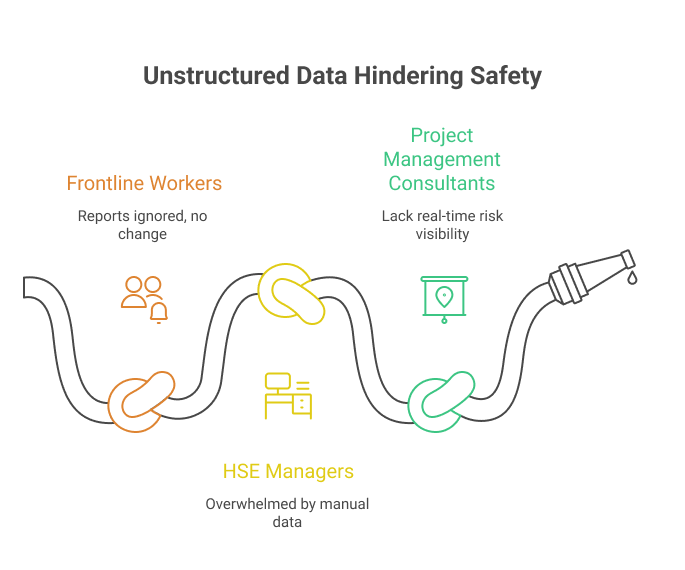Construction sites generate vast amounts of safety data through observations (near-misses, hazards, unsafe conditions) and incidents (injuries, property damage, safety violations). However, this critical data was trapped in chaos—scattered across communication channels and legacy systems that couldn't transform it into proactive insights.
🚨 Problem 1: Unstructured Data Chaos
Safety event data—both observations and incidents—was scattered across WhatsApp groups, email threads, paper forms, and various communication channels. Critical safety information existed but was impossible to analyze, prioritize, or act upon systematically. HSE teams manually hunted through messages to find important events, with no structured way to connect observations to potential incidents.
🖥️ Problem 2: Legacy Systems Without Intelligence
Existing desktop safety recording systems were essentially digitized forms—no AI, no smart routing, no predictive capability. They captured data but provided zero intelligence. HSE teams manually reviewed every observation and incident to determine severity, urgency, and patterns. There was no way to identify leading indicators or predict which observations might escalate into serious incidents.
📊 Problem 3: Data Never Became Actionable Insights
Frontline workers felt their safety reports disappeared into a void. The feedback loop was broken—they reported hazards and near-misses but never saw outcomes or preventive action. Meanwhile, HSE teams spent 4-6 hours daily manually triaging events, with critical risks buried in hundreds of low-priority reports. Historical data existed but wasn't being used to predict and prevent future incidents. The fundamental issue: reactive safety management instead of predictive hazard identification.
Stakeholder Pain Points
- 👷 Frontline Workers: "We report hazards but nothing changes". Safety events lost in WhatsApp groups with no visibility into whether reports drive action.
- ⚠️ HSE Managers: Overwhelmed by volume, spending excessive time manually reading, classifying, prioritizing, and assessing data trapped in unstructured formats. This led to critical observations being missed or delayed and reactive responses instead of predictive prevention.
- 👨💼 Project Management Consultants (PMC): Lacked real-time visibility into leading risk indicators across the project, making it difficult to prioritize high-risk sites or allocate resources effectively.

